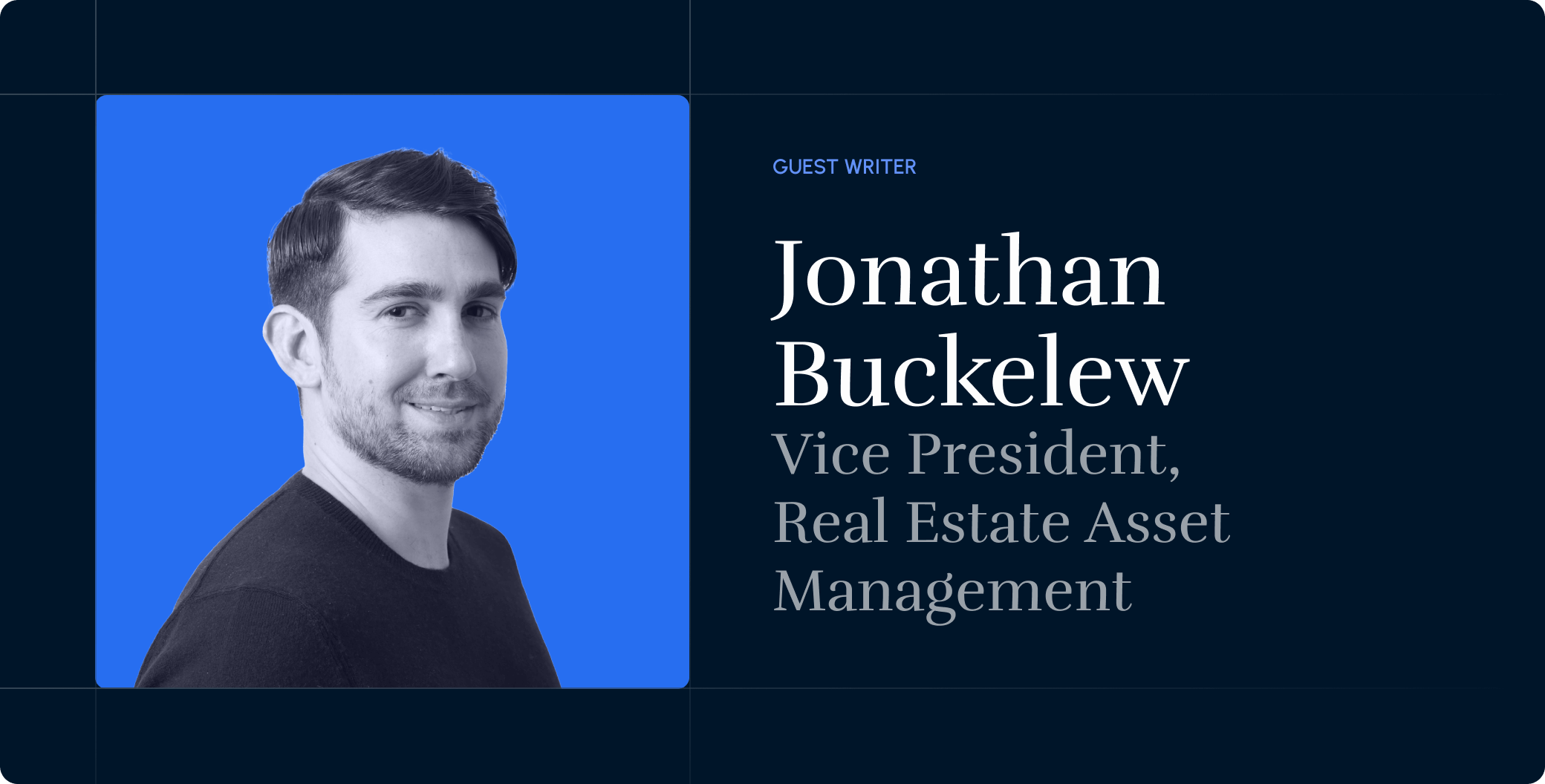Deloitte’s 2025 report on front-burner trends in commercial real estate reveals that elevated interest rates have gone from a ranking of 7th in 2024 to the number one spot as the primary concern of industry respondents.
Commercial real estate interest rates in May 2025 range from just over 5% to above 15%, depending on the asset class and loan structure.
With nearly $1 trillion in CRE debt maturing in 2025, understanding the factors behind rate pricing is more critical than ever. The following article focuses on commercial real estate interest rates, key factors influencing them, and their impact on commercial real estate investments.
Overview of current CRE interest rates (May 2025)
This section provides a snapshot of the current prevailing commercial real estate financing interest rates, segmented by asset type and loan program. May 2025 continues to reflect instability in the commercial real estate market, where monetary policy, borrower profiles, and asset stability drive rate variability.
Rate breakdown by commercial property type
- Multifamily: These are residential rental buildings, including apartments, student housing, and other similar accommodations. Rates here are often lower because housing demand tends to be consistent. Institutional investors and agencies, such as Fannie Mae and Freddie Mac, heavily finance this sector.
- Retail: This includes shopping centers, strip malls, and standalone retail. Rates vary based on lease terms and the tenant’s financial strength.
- Industrial: Includes warehouses, manufacturing facilities, and logistics centers. Due to e-commerce, this sector has experienced significant growth. If the facility is new and leased to a reputable company, interest rates are likely to be favorable.
- Office: This sector remains more volatile in the post-COVID era. Vacancy is high. A fully leased Class A building in a good location may get decent terms, but rates tend to be higher to compensate for market risk.
Current commercial real estate interest rates by property type
| Property type | Typical interest rate range | Notes |
| Multifamily | 5.35% – 7.75% | Lower risk due to stable demand |
| Retail | 6.00% – 12.00% | Depends on tenant mix and lease stability |
| Industrial | 5.50% – 7.50% | Strong demand from logistics and e-commerce |
| Office | 6.50% – 12.00% | Higher risk due to post-COVID vacancy |
SBA loan options
| Loan program | Typical interest rate range | Notes |
| SBA 504 loans | 6.20% – 6.41% | Fixed-rate, government-backed, owner-occupied |
| SBA 7(a) loans | 12.50% – 15.50% | Flexible use; variable-rate |
How are commercial real estate interest rates calculated?
Commercial real estate loan rates are determined by a few core components that reflect both market conditions and deal-specific risks:
- Base rate: Most loans are anchored to a benchmark such as:
- SOFR – the standard rate for institutional lending, replacing LIBOR
- Prime rate – what banks offer top-tier clients
- Federal funds rate – set by the Fed, influencing nearly all lending rates
- Loan-to-Value (LTV) ratio: This indicates the percentage of a property’s value that a lender will finance. Lower LTV means less risk for the lender and typically a better interest rate. Most conventional loans fall between 65% and 80% LTV, while SBA 504 loans can reach up to 90%.
- Credit spread: This risk premium is added to the base rate. The riskier the borrower or property, the higher the spread and the interest rate.
- Loan profile: Lenders also assess the loan’s structure. Short-term loans, transitional assets, or weaker cash flows often come with higher rates. Stabilized, income-producing properties in strong markets generally qualify for better terms.
Key factors influencing CRE interest rates
Many factors affect interest rates, which in turn influence the decisions of commercial real estate investors and developers.
Federal Reserve policies
The Fed adjusts interest rates to control inflation and economic growth. Raising the federal funds rate makes borrowing more expensive, which slows the economy but softens inflation. Lowering the rate encourages spending and investment. These shifts directly influence all commercial real estate loan rates.
Economic indicators
Economic indicators shape the Federal Reserve’s decision-making process, which affects the cost of borrowing in the commercial property market. Key indicators include:
- Consumer Price Index (CPI): Measures average price changes paid by consumers for goods and services
- Personal Consumption Expenditures (PCE): The Fed’s preferred inflation gauge, providing a broader measure than CPI
- Gross Domestic Product (GDP): Reflects overall economic health. Strong GDP growth can drive higher interest rates, while sluggish growth may lead to rate cuts
- Employment numbers: Low unemployment and wage growth can contribute to inflation, which can push interest rates higher
Market dynamics
Market dynamics reflect the interaction of capital markets, investor sentiment, and shifts in supply and demand within the commercial property lending space. These include:
- Borrower demand: When demand for commercial real estate loans is high, lenders can command higher interest rates due to increased competition for capital
- Lender risk perception: Periods of increased loan defaults or declining property values make lenders more cautious, leading to more stringent underwriting standards and reduced loan-to-value ratios
- Capital supply and liquidity: When capital flows freely, lenders may offer more competitive pricing. However, if capital becomes limited due to tougher lending standards, borrowing costs can rise sharply
Types of CRE loans and their interest structures
Each loan type has a unique purpose, structure, and pricing model to cater to the needs of commercial property investors.
Fixed vs. variable rates
- Fixed rate: Stays the same through the term. Ideal for stable, long-term investments and easier for cash flow planning.
- Variable rate: Changes in accordance with a benchmark index, such as SOFR. Starts lower but can rise. Useful in short-term or repositioning strategies.
Comparison – Fixed interest rate vs. variable interest rate loans
| Feature | Fixed rate loan | Variable rate loan |
| Rate stability | Constant over the loan term | Fluctuates with market benchmarks |
| Risk level | Lower | Higher (due to potential rate hikes) |
| Suitable for | Long-term, stabilized investments | Short-term or repositioning projects |
| Cash flow predictability | High | Variable |
| Initial rate level | Slightly higher | Often starts lower |
Loan products
CMBS loans: Fixed-rate, non-recourse loans bundled and sold as investment securities. Commonly used for stabilized, income-producing properties.
NNN single-tenant loans: Financing for properties leased to a single tenant who covers taxes, insurance, and maintenance. Lower risk due to predictable cash flow.
Owner-occupied loans: For businesses buying and using their own commercial space. Generally, more favorable rates.
Mobile home park loans: Specialized loans with unique underwriting. Slightly higher rates due to non-traditional asset class considerations.
Mezzanine financing: A blend of debt and equity, mezzanine financing sits behind senior debt, providing a middle layer of financing. Used when additional leverage is needed.
Freddie Mac / Fannie Mae multifamily loans: Government-backed, low-rate loans for multifamily properties.
HUD multifamily loan: Very low fixed-rate loans for affordable housing. Long closing times but extremely favorable terms.
Bridge loans: Short-term loans (12–36 months) used for acquisitions, renovations, or lease-up. Higher rates due to risk and lack of long-term cash flow.
How to choose the best commercial real estate loan
Choosing the right loan can make or break a commercial real estate investment. The ideal loan should balance cost, flexibility, and alignment with your investment goals. Investors should consider the loan term, rate structure, loan-to-value (LTV) ratio, and prepayment terms, matching these with their investment strategy—whether long-term hold or opportunistic investment.
Impact of interest rates on CRE investments
Interest rate shifts directly influence how assets are priced, the amount of debt investors can take on, and the returns they can expect. Understanding this relationship is essential for making informed investment decisions.
| Metric | Low interest rate environment | High interest rate environment |
| Property valuation | Cap rates fall, values rise | Cap rates rise, values decline |
| Internal Rate of Return (IRR) | Improved cash-on-cash, easier leverage | Lower returns unless offset by rent growth |
| Financing flexibility | Easier to obtain and structure debt | Requires more equity or alternative capital |
| Refinancing risk | Lower | Higher, especially if asset value declines |
Navigating the current CRE financing landscape
The commercial real estate financing environment in May 2025 presents both challenges and opportunities for investors and borrowers. Higher interest rates, lender caution, and tighter underwriting standards have reshaped the lending market.
| Challenges | Opportunities |
| Tighter lender standards: Lenders are demanding stricter credit checks, higher equity requirements, and more conservative loan terms to mitigate risk. | Lower competition for acquisitions: With many buyers sidelined by rate hikes and uncertainty, active investors face less bidding competition. |
| Higher rates reduce borrowing power: Borrowing costs are up, often forcing buyers to bring more equity or lower purchase offers. | Better pricing from distressed or motivated sellers: Owners facing debt maturity, declining net operating income (NOI), or capital shortfalls may offer discounts. |
| Many existing loans maturing in 2025 may not be refinanced at their original loan amounts: Rising cap rates and declining valuations could create funding gaps. | Creative structures: Seller carry, participation debt, and other alternative financing can help bridge gaps, reduce equity needs, and unlock deals. |
Conclusion
As the market adjusts to higher interest rates and tighter credit, informed borrowing strategies will be key to staying competitive. Investors who understand rate dynamics, loan options, and market trends will be best positioned to adapt and grow in 2025. When approaching commercial real estate financing, working with experienced debt funds and understanding commercial mortgage benefits can provide strategic advantages in this challenging commercial real estate landscape.










